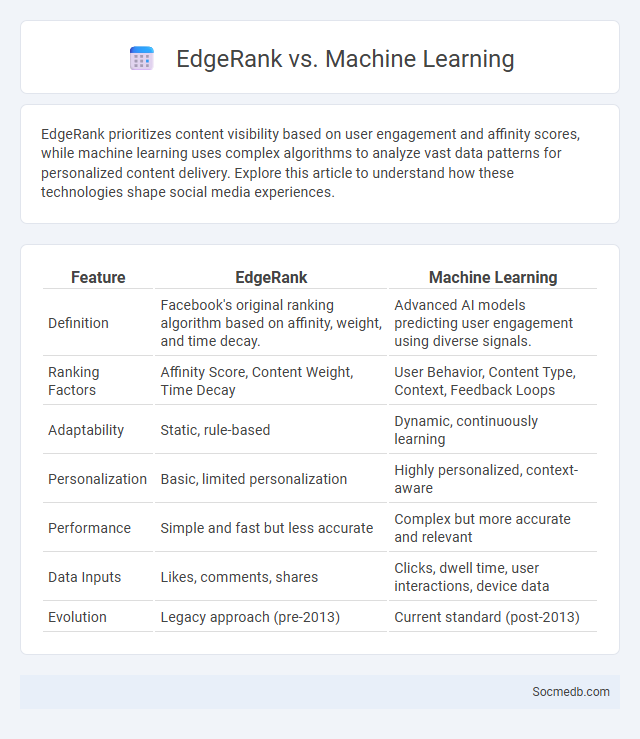
Photo illustration: EdgeRank vs Machine Learning
EdgeRank prioritizes content visibility based on user engagement and affinity scores, while machine learning uses complex algorithms to analyze vast data patterns for personalized content delivery. Explore this article to understand how these technologies shape social media experiences.
Table of Comparison
| Feature | EdgeRank | Machine Learning |
|---|---|---|
| Definition | Facebook's original ranking algorithm based on affinity, weight, and time decay. | Advanced AI models predicting user engagement using diverse signals. |
| Ranking Factors | Affinity Score, Content Weight, Time Decay | User Behavior, Content Type, Context, Feedback Loops |
| Adaptability | Static, rule-based | Dynamic, continuously learning |
| Personalization | Basic, limited personalization | Highly personalized, context-aware |
| Performance | Simple and fast but less accurate | Complex but more accurate and relevant |
| Data Inputs | Likes, comments, shares | Clicks, dwell time, user interactions, device data |
| Evolution | Legacy approach (pre-2013) | Current standard (post-2013) |
Introduction to EdgeRank and Machine Learning
EdgeRank, Facebook's algorithm, determines which posts appear in Your News Feed by evaluating factors such as affinity, weight, and time decay to enhance user engagement. Machine learning algorithms further optimize content delivery by analyzing user behavior patterns and preferences, ensuring more personalized and relevant social media experiences. Understanding these technologies helps you create content strategies that effectively increase visibility and interaction on social platforms.
The Evolution of Facebook’s EdgeRank Algorithm
Facebook's EdgeRank algorithm has significantly evolved from its original focus on ranking posts based on affinity, weight, and decay to a more complex machine learning system that prioritizes meaningful interactions and user engagement. Your newsfeed now reflects content that aligns with your interests, preferences, and past behavior, ensuring you see relevant updates from friends, pages, and groups. This evolution enhances user experience by delivering personalized content while reducing spam and clickbait.
Understanding the Basics of Machine Learning in Social Feeds
Machine learning in social feeds involves algorithms that analyze user behavior and interactions to personalize content delivery, increasing engagement and relevance. By processing large datasets of likes, shares, comments, and viewing time, these models predict and prioritize posts that align with individual preferences. Understanding the basics of machine learning enables better comprehension of how platforms like Facebook, Instagram, and Twitter curate content to enhance user experience and advertising efficiency.
Key Differences: EdgeRank vs Machine Learning
EdgeRank, Facebook's original algorithm, primarily relied on affinity, weight, and time decay to determine content visibility, focusing on user interaction recency and type. Machine learning algorithms, however, analyze vast datasets in real-time, incorporating user behavior patterns, content relevance, and engagement probabilities to personalize feed ranking dynamically. Unlike EdgeRank's fixed formula, machine learning continuously adapts to evolving user preferences and platform changes, enhancing content discovery and user experience.
How EdgeRank Shaped Early Social Media Engagement
EdgeRank, Facebook's original algorithm, prioritized content based on user interactions such as likes, comments, and shares, significantly shaping early social media engagement strategies. This ranking system encouraged users and brands to create more interactive and relevant posts to appear higher in news feeds, boosting organic reach. By emphasizing user affinity, content weight, and recency, EdgeRank laid the foundation for personalized content delivery and engagement optimization on social media platforms.
The Shift from EdgeRank to Advanced Machine Learning
The shift from Facebook's EdgeRank algorithm to advanced machine learning models has revolutionized social media content curation by enhancing personalization and engagement. Machine learning leverages vast datasets and user behavior patterns to deliver more relevant, timely posts and advertisements, improving the overall user experience. This evolution supports dynamic ranking signals and real-time adjustments, driving higher retention and platform growth.
Predictive Power: Machine Learning’s Role in Feed Ranking
Machine learning enhances social media feed ranking by analyzing vast amounts of user data to predict content relevance and engagement. Algorithms leverage behavioral patterns, click history, and interaction metrics to deliver personalized feeds that increase user retention and satisfaction. Your experience on social platforms improves as predictive models continuously adapt to preferences, optimizing content visibility in real time.
Limitations of the Original EdgeRank Algorithm
The original EdgeRank algorithm, used by Facebook to rank news feed stories, primarily relied on affinity, weight, and time decay factors, limiting its ability to capture diverse user interests and nuanced content relevance. It struggled with prioritizing meaningful interactions and failed to account for evolving user behavior or the varied significance of different content types, leading to reduced personalization accuracy. These limitations prompted the shift toward more complex, machine learning-based algorithms that analyze a broader set of signals for improved user engagement.
Benefits of Machine Learning Over Traditional EdgeRank
Machine learning enhances social media algorithms by analyzing vast amounts of user data to deliver highly personalized content recommendations, surpassing the rigid rules of traditional EdgeRank. It adapts in real-time to your behavior and preferences, optimizing engagement and relevance without manual adjustments. This results in a more dynamic, accurate, and user-centric feed that continually improves user experience.
The Future of Feed Ranking: Beyond EdgeRank and Current AI
The future of feed ranking will evolve significantly beyond the traditional EdgeRank algorithm by integrating advanced AI models that prioritize personalized content relevance and user engagement metrics. Emerging technologies harness machine learning to analyze deeper behavioral patterns, enabling platforms to deliver more tailored experiences that align with Your interests and preferences. This shift enhances content discovery, ensuring that feed rankings adapt dynamically to changing user dynamics and platform ecosystems.
 socmedb.com
socmedb.com